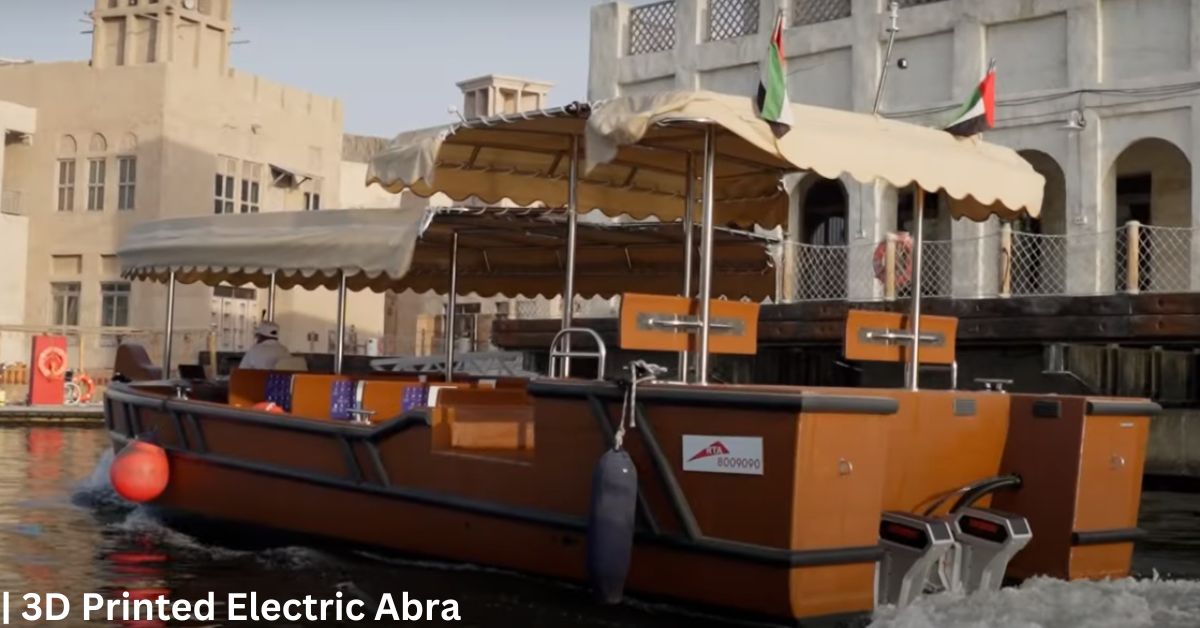Dubai has begun trials of the world’s first 3d printed electric Abra. The Roads and Transport Authority (RTA) of Dubai introduced this groundbreaking boat, which is now being tested in real-world conditions. This new Abra is designed to be eco-friendly and cost-effective, supporting Dubai’s plan to make public transportation more sustainable.
Physical Features of 3D Printed Electric Abra
The 3d printed electric Abra being tested in Dubai has the following physical features:
- Dimensions: The boat measures 8 meters in length and 2.8 meters in width, providing a spacious area for passengers while still being compact enough for easy navigation in urban waterways.
- Load Capacity: It has a maximum load capacity of 1.5 tons, allowing it to safely transport passengers along with their belongings.
- Passenger Capacity: The Abra is designed to seat up to 20 passengers, making it suitable for short water journeys, such as crossing rivers or traveling along coastal routes.
- Lightweight Design: The use of 3D printing technology allows for a lightweight structure, which improves its efficiency and reduces energy consumption while maintaining strength and durability.
- Electric Motor: Powered by an electric motor, the Abra is eco-friendly, producing no emissions and operating quietly compared to traditional boats that use diesel engines.
- Modern Appearance: The boat boasts a sleek, contemporary design with smooth lines, giving it a modern and visually appealing look on the water.
- Robust Materials: Constructed from high-quality materials suitable for 3D printing, the Abra is built to withstand regular use and challenging water conditions, ensuring a long service life.
These features highlight the Abra’s innovative design and suitability for sustainable water transportation in urban environments.
Other Features of the 3d Printed Electric Abra
- Eco-Friendly: The new Abra runs on electric power, which means it does not release harmful emissions. This makes it a greener choice compared to traditional boats that use diesel engines.
- Cutting-Edge Technology: This Abra is created using 3D printing, which is faster and cheaper than traditional boat-building methods. 3D printing allows for a lightweight yet strong design, making the boat more efficient on the water.
- Cost-Effective Production: Using 3D printing technology reduces the time and costs associated with building a boat. It requires less manual labor and fewer materials, making it a more economical choice for future boat production.
- Modern Design: The Abra features a sleek, modern design using advanced materials that are both durable and sustainable. This makes the boat not only attractive but also long-lasting.
Importance of the Trial Runs
The trial runs of the 3d printed electric Abra are an important milestone for Dubai’s transportation network. If these trials are successful, Dubai could see more 3D-printed electric boats on its waterways. The RTA aims to use these innovative boats to lower pollution levels and offer a better experience for passengers.
Future Goals
Dubai is committed to advancing its public transportation technology. The city aims to make its transport system more environmentally friendly by 2030. The new Abra plays a significant role in this vision. The RTA believes that using electric and 3d printed boats will help them reach their sustainability targets, providing cleaner and more affordable transportation options for everyone.
Conclusion
The testing of the world’s first 3D-printed electric Abra in Dubai represents a significant step forward in water transport innovation. This boat is not only a technological breakthrough but also a move towards a greener future. As Dubai continues to embrace new technologies, it sets a powerful example for other cities to follow in creating sustainable and efficient public transportation systems.
3D printing is taking the world by storm. It is proving to be a very useful tech in every field. If you enjoyed reading this article please let me know in comments.
Defects in FDM 3D Printing
